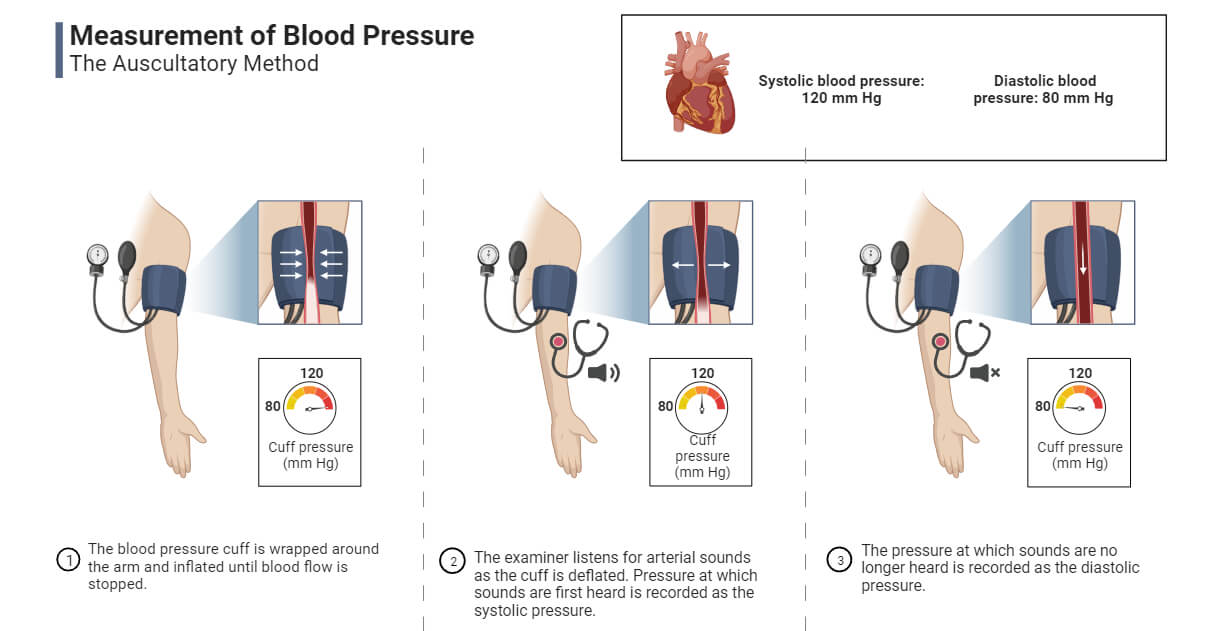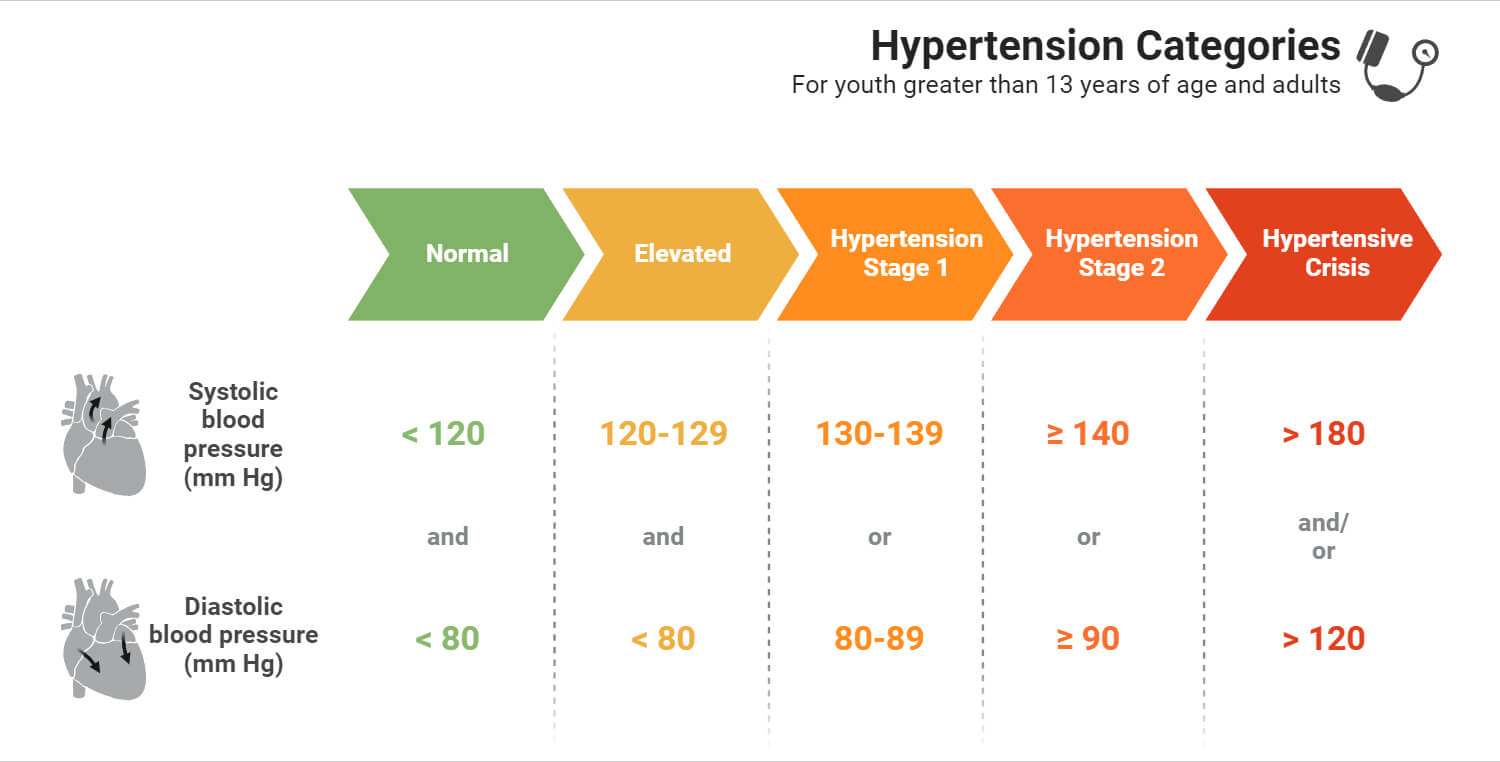Blood pressure is the measure of the pressure developed against the wall of the arteries by the circulating blood. It is the measure of the pressure of the blood in the major arteries during the systole and diastole stages of the cardiac cycle. It is also called the systemic arterial pressure.

- It is measured in ‘mm of Hg’. It is a very important physiological parameter measured to determine the health condition of an individual. Blood pressure together with heart sound is an indicator of the condition of the cardiovascular system. Any abnormalities in these indicate that the patient is suffering from one or more cardiovascular diseases.
- The blood pressure is expressed as systolic pressure and diastolic pressure. The normal blood pressure of a human is 120/80 (systolic/diastolic) mm of Hg. The instrument used to measure human blood pressure is called a sphygmomanometer.
Interesting Science Videos
What is Systolic Blood Pressure?
It is the blood pressure developed against the wall of the arteries by the circulating blood during the ventricular contraction (ventricular systole) stage of a heartbeat. It is the maximum pressure exerted in arteries during a heartbeat. During ventricular systole, the heart’s muscular wall contracts and propels the blood out of the heart into the aorta and pulmonary trunk at higher pressure. This high pressure ensures the circulation of blood to every tissue and cell of our body. In normal conditions, it is about 120 mm of Hg.
What is Diastolic Blood Pressure?
It is the blood pressure developed against the wall of the arteries by the circulating blood during the ventricular relaxation (ventricular diastole) stage of a heartbeat. It is the minimum pressure exerted in arteries during a heartbeat. After ventricular contraction, the heart’s muscles relax and allow the blood from the atria to enter the ventricle. During this stage, the blood pressure is minimum in the arteries. In normal conditions, it is about 80 mm of Hg.
Measurement of Atrial Blood Pressure
- When we talk about blood pressure, commonly abbreviated as BP, we are only talking about atrial blood pressure. The walls of veins and capillaries also experience blood pressure, but they are typically very low and difficult to measure. Capillary blood pressure is about 20 to 30 mm of Hg while the BP in the vein is generally about 8 mm of Hg and may also reach to negative value. Hence, they are considered insignificant for medical purposes and mostly not measured.
- Atrial blood pressure is measured using a medical device called the sphygmomanometer often coupled with a stethoscope. This device contains an inflatable cuff and a mercury pressure gauge.
- The cuff is generally wrapped around the arm over the brachial artery and it is inflated to apply pressure to the brachial artery by squeezing the attached bulb. Once it is inflated to the desired level, a stethoscope is placed over the brachial artery of the elbow. The pressure inside the cuff is reduced by slowly releasing the pumped air. This release of air allows the blood to flow through the brachial artery producing a characteristic sound called the ‘Korotkoff sound’. The first sound is heard during the pressure gauge indicating the systolic pressure and the second sound is heard during the pressure gauge indicating the diastolic pressure. Hence, the pressure indicated in the pressure gauge when the first and the second Korotkoff sound are heard is noted.
Mechanism of Regulation of Blood Pressure
Blood pressure is regulated by various mechanisms, mainly by two major mechanisms viz. the baroreceptor reflex and the renin-angiotensin-aldosterone system (RAAS). Besides, there are several other minor mechanisms including low-pressure baroreceptor, antidiuretic hormone, atrial natriuretic peptide, fluid and electrolyte level, kidney function, etc.
Baroreceptor Reflex
Baroreceptors are mechanoreceptors located inside our blood vessels. There are two major baroreceptors each located inside the carotid sinus and aortic arch. The carotid baroreceptor responds to both increases and decreases in blood pressure and sends the signal to the medulla oblongata of the CNS via the glossopharyngeal nerve. The aortic baroreceptor responds to an increment in blood pressure and sends the signal to the medulla oblongata via the vagus nerve. Once receiving signals from these baroreceptors, the brain will adjust sympathetic and parasympathetic neural activity resulting in regulation of the blood pressure by changing heart rate, vessels diameter, and cardiac action potential.
Renin-Angiotensin-Aldosterone System (RAAS)
RAAS is a hormonal system for regulating blood pressure by changing blood volume and diameters of blood vessels. Reduction in renal blood flow, reduced blood pressure, reduced sodium (Na+) in the distal convoluted tube (DCT) of a nephron, and impulse from the sympathetic nervous system stimulate the release of ‘renin’ hormone from the juxtaglomerular cells of the kidney. The released renin enters the bloodstream and meets with the angiotensinogen protein released by the liver. Renin converts the angiotensinogen into angiotensin – I. The angiotensin-converting enzyme (ACE) produced mainly by the vascular endothelial cells converts angiotensin – I into angiotensin – II. Angiotensin – II regulates the fluid and electrolytes and blood pressure by the following mechanisms:
- Contracting the smooth muscles in the arterial walls causing vasoconstriction. Vasoconstriction will then increase the blood pressure.
- Stimulating the production of aldosterone from the adrenal cortex. The aldosterone upregulates the Na+/K+ pumps of the DCT and causes increased reabsorption of sodium and water. This increased reabsorption will increase blood pressure.
- Stimulating the release of more vasopressin hormone from the pituitary gland. Vasopressin will also increase the reabsorption of water as well as contract the arterioles.
Abnormal Blood Pressure
If the blood pressure increases or decreases than the normal range, then we say it the abnormal blood pressure. Abnormality in blood pressure is of two types, the first is an increase in blood pressure than normal called hypertension; the second is a decrease in blood pressure than normal called hypotension. Both these are regarded as types of cardiovascular disorders.
Hypertension
If the systolic and diastolic blood pressure increases than the normal range, it is termed hypertension. If the systolic pressure exceeds 129 mm of Hg and diastolic pressure exceeds 80 mm of Hg, then the situation is called hypertension.
The rise of systolic pressure up to 129 mm of Hg is termed elevated pressure, but if it increases about 130 to 139 mm of Hg it is called stage 1 hypertension, if it increases above 140 mm of Hg then it is called stage 2 hypertension, and if it crosses 180 mm of Hg it is referred as hypertensive crisis.
If the diastolic pressure increases about 80 to 89 mm of Hg it is called stage 1 hypertension, if it increases above 90 mm of Hg then it is called stage 2 hypertension, and if it crosses 120 mm of Hg it is referred to as a hypertensive crisis.

Hypotension
If the systolic and diastolic blood pressure decreases than the normal range, it is termed hypotension. If the systolic pressure falls behind 90 mm of Hg and diastolic pressure fall behind 60 mm of Hg, then the situation is called hypotension.
References
- Ross & Wilson Anatomy & Physiology in Health and Illness. 13th ed. Churchill Livingstone Elsevier. ISBN 978-0-7020-7276-5
- Stauss H. M. (2007). Identification of blood pressure control mechanisms by power spectral analysis. Clinical and experimental pharmacology & physiology, 34(4), 362–368. https://doi.org/10.1111/j.1440-1681.2007.04588.x
- Campbell M, Sultan A, Shumway KR, et al. Physiology, Korotkoff Sound. [Updated 2022 Sep 7]. In: StatPearls [Internet]. Treasure Island (FL): StatPearls Publishing; 2023 Jan-. Available from: https://www.ncbi.nlm.nih.gov/books/NBK539778/
- Britannica, The Editors of Encyclopaedia. “sphygmomanometer”. Encyclopedia Britannica, 6 Mar. 2023, https://www.britannica.com/technology/sphygmomanometer. Accessed 8 June 2023.
- Britannica, The Editors of Encyclopaedia. “blood pressure”. Encyclopedia Britannica, 5 Jun. 2023, https://www.britannica.com/science/blood-pressure. Accessed 8 June 2023.
- Shahoud JS, Sanvictores T, Aeddula NR. Physiology, Arterial Pressure Regulation. [Updated 2022 Aug 29]. In: StatPearls [Internet]. Treasure Island (FL): StatPearls Publishing; 2023 Jan-. Available from: https://www.ncbi.nlm.nih.gov/books/NBK538509/
- Fountain JH, Kaur J, Lappin SL. Physiology, Renin Angiotensin System. [Updated 2023 Mar 12]. In: StatPearls [Internet]. Treasure Island (FL): StatPearls Publishing; 2023 Jan-. Available from: https://www.ncbi.nlm.nih.gov/books/NBK470410/
- https://teachmephysiology.com/urinary-system/regulation/the-renin-angiotensin-aldosterone-system/
- Blood pressure. (2023, May 29). In Wikipedia. https://en.wikipedia.org/wiki/Blood_pressure
- https://www.cdc.gov/bloodpressure/about.htm#:~:text=high%20blood%20pressure%3F-,What%20is%20blood%20pressure%3F,and%20falls%20throughout%20the%20day.
- https://www.heart.org/en/health-topics/high-blood-pressure/understanding-blood-pressure-readings
- https://www.slideshare.net/ananthatiger/blood-pressure-mechanism
- https://www.slideshare.net/drchintansinh/bp-regulation
- https://www.cliffsnotes.com/study-guides/anatomy-and-physiology/the-cardiovascular-system/control-of-blood-pressure
- https://geekymedics.com/regulation-of-blood-pressure/
- https://www.nhs.uk/common-health-questions/lifestyle/what-is-blood-pressure/
- https://www.betterhealth.vic.gov.au/health/conditionsandtreatments/blood-pressure
- https://my.clevelandclinic.org/health/diseases/17649-blood-pressure
